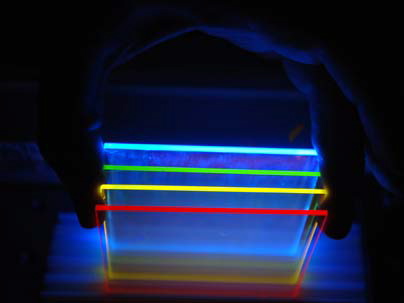The annoying thing about all the clean energy technologies is that we can’t buy them and use them. Breakthroughs keep being reported, and then . . . nothing. If I had a solution to that problem, I’d be a lot richer than I am, but I’m a dreamer like everyone else. So, just to give you some more things to dream about, here are three advances on the energy front. (Life happened, so this is a few weeks past due, as usual for me.)
First is the discovery of how to channel light so that any window can act as a solar collector. Channeling light has been done since the first days of fiberoptics, and collecting light is the big problem facing photovoltaics. So it seems like somebody should have done this decades ago. As it happens, they tried in the 1970s. But there were no materials at the time capable of efficiently channeling light in the precise way required, nor did we have the right light-absorbing dyes. Materials scientists are the unsung heroes of the tech world.
 (Photo / Donna Coveney)
(Photo / Donna Coveney)
From the MIT press release [1]:
Organic solar concentrators collect and focus different colors of
sunlight. Solar cells can be attached to the edges of the plates. By collecting light over their full surface and concentrating it at their edges, these devices reduce the required area of solar cells and consequently, the cost of solar power. Stacking multiple concentrators allows the optimization of solar cells at each wavelength, increasing the overall power output.
The associated FAQ [2] notes that — sigh! — more work needs to be done.
We tested one of our devices and found that it was stable (to 92 percent of initial performance) for three months. This isn’t good enough yet for products but we are confident that the technology developed for organic light emitting devices (OLEDs) in televisions will be portable to this application. . . . . The technology is being further developed for commercialization . . . . The team believes that it could be implemented within three years.
Next is half of a breakthrough in fuel cells [3], also out of MIT. Two of the issues with fuel cells are that the electrodes are platinum (expensive) and that platinum doesn’t liberate oxygen readily (wastes energy). It works well on hydrogen, but if the oxygen refuses to let go that slows the whole system down. The recent invention involves a new, cheaper catalyst for oxygen with much improved yield. Not only that but it works at room temperature and in ordinary (not ultrapure) distilled water. There are, naturally, all sorts of boring details to be worked out before it can be scaled up to industrial production. (Harrumph.)
The other half of the breakthrough is a replacement for the platinum catalyst from Monash University in Melbourne. A PEDOT-plus-Gore-tex [4] (I kid you not!) organic electrode turns out to work as well as platinum. Not only that, but it didn’t have problems with carbon monoxide, which affects platinum, and it works in a neutral (e.g. water) instead of alkaline environment.
The implications are huge. Solar power has had three problems: producing enough power, storing it, and distributing it. The last two are actually much bigger issues than the first, which has pretty much been solved. What these two breakthroughs do is solve both the latter issues at once. It would become feasible for households to store their daytime PV energy in fuel cells to be used at night or to assist in electric vehicles as needed. Gone is the need to wheel vast amounts of energy from day to night or to store it in enormous batteries or reservoirs. The utilities would still need to wheel some power, but probably not much more than they do now. Maybe less. Solar energy is now officially practical. It’s all over but the shouting.
The last breakthrough involves a new thermoelectric material. Heat engines don’t usually grab people (except, of course, on coffee cups [5]), but in this case we’re talking about turning heat directly into electricity at higher efficiency than before.
Anything that loses lots of heat could be a candidate for this technology, although currently it works best at engine temperatures. Internal combustion engines waste phenomenal amounts of heat, whether they’re in vehicles or power generators. Heat pumps (of which air conditioners are a subset) are also culprits.
From Ohio State via RenewableEnergyWorld.com [6]:
For this new material . . . they took advantage of some new ideas in quantum mechanics. . . . a 2006 paper published by other researchers in the journal Physical Review Letters, . . . suggested that elements such as thallium and tellurium could interact on a quantum-mechanical level to create a resonance between the thallium electrons and those in the host lead telluride thermoelectric material, depending on the bonds between the atoms.
“It comes down to a peculiar behavior of an electron in a thallium atom when it has tellurium neighbors,” he said. “We’d been working for 10 years to engineer this kind of behavior using different kinds of nanostructured materials, but with limited success. Then I saw this paper, and I knew we could do the same thing we’d been trying to do with nanostructures, but with this bulk semiconductor instead.”
Recapture of energy lost as heat could be the second biggest power source after solar. Like solar, we’re pretty much wasting that, too.
But, who knows?, if we see how much we’re missing, maybe we’ll decide it’s worth the effort to get it.
Technorati Tags: solar, energy, power, heat engine, fuel cells